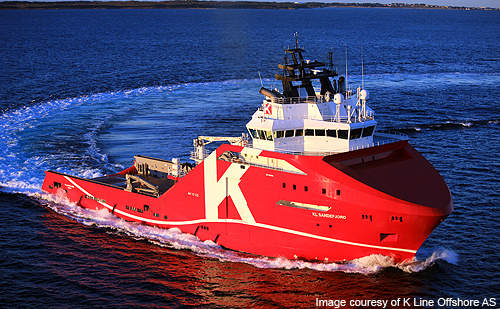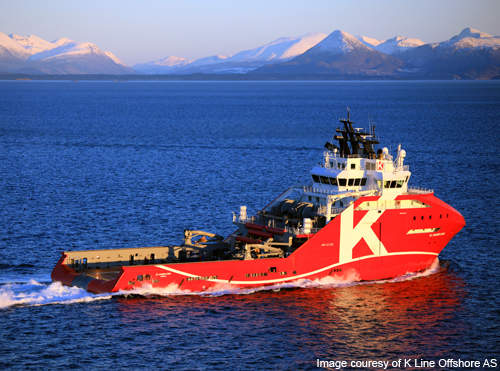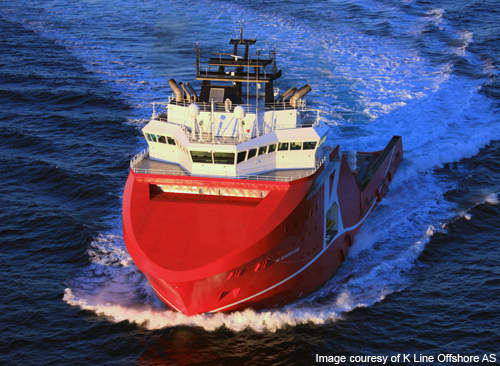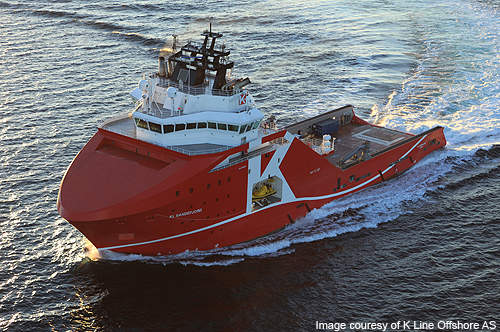The KL Sandefjord Anchor Handling Tug Supply (AHTS) vessel is owned by K Line Offshore (Kawasaki Kisen Kaisha). It is a multifunction vessel designed to carry out seabed operations, ploughing / trenching and pre-lay work in ultra-deep waters and harsh environments. With a bollard pull of 390t, it the world’s strongest AHTS vessel constructed to date.
The ship was delivered to K Line on 7 January 2011 after successfully completing sea trials in December 2010. The vessel will begin operating after the installation and testing of the A-frame at Kristiansand harbour in southern Norway.
Design
KL Sandefjord is the first of two AHTS vessels of AH 12 CD design. It is 95m-long and 24m-wide with 9.8m depth to the centre of the main deck. It has a maximum draught of 7.82m and a cargo rail height of 3.10m above the deck.
The deadweight capacity is 4,800t with cargo deck area measuring about 750m². The deck can carry cargo weighing up to 3,200t. The free area on the deck can carry 10t/m² of cargo.
The A-frame is fitted on the deck for subsea construction works. It weighs 250t and has an inside width of 15,500mm between the legs at deck level. The top width is 10,500mm and inside height is 11,100mm. The outreach is 8.5m at the aft and 4.55m forward the A-frame pivot point.
Construction
The hull was constructed by STX Norway Offshore in Tulcea, Romania. The construction was supervised by Norway-based OSM Group.
The hull was launched in February 2010. It was towed to position alongside the tug Pegasus and then towed to STX Norway Offshore’s Langsten shipyard in Tomrefjord in Alesun County, Norway for final outfitting. Naming ceremony was held in November 2010.
Equipment
The vessel is fitted with ROV hangar and ODIM LARS system for underwater search operations and handling of anchors respectively. An ODIM Anchor Recovery Frame (ARF) is fitted on aft deck to handle Torpedo type anchors. It is flush with the main deck when in stowed position.
The two jib RRM cargo rail cranes are equipped with manipulators for safe operations of the working area on the deck.
Large chain and synthetic fibre rope of different capacities are available on the deck.
Propulsion
KL Sandefjord has a highly efficient power plant designed and built by Finland-based Wärtsilä. It consists of two 16v 32-type main engines and 2,200kW, five diesel generators with alternators connected to the main switchboard.
The engines are connected to shaft lines through reduction gears and controlled pitch propellers (CPP) which can be powered using diesel-electric, diesel-mechanical or hybrid modes. The two main CPPs have four blades that rotate at a speed of 130rpm.
The three thrusters-two tunnel thrusters forward and one tunnel thruster to the aft are fixed with fixed pitch propellers. The thrusters operate at variable speeds, regulated by frequency controlled motors.
Accommodation
The vessel can accommodate 70 people on board. There are 45 cabins of which six single berth cabins are reserved for officers. The rest are 14 single berth and 25 double berth cabins for crew members.
Facilities
Facilities on board include a conference room, lounges and internet access.
Decks A and D have a client office and a conference room while Deck C has only client office. The bridge accommodates one ship office. Deck A houses a lounge which is fully equipped with satellite TV and home theatre system. Deck B has two lounges with similar facilities.
All the cabins have local area network (LAN) connections. V-sat is provided separately for client internet and telephone lines.
Other major facilities include a gym and a hospital for officers and crew members.





